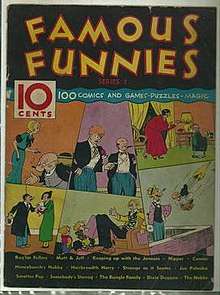Famous Funnies
| Famous Funnies | |
|---|---|
.jpg) Famous Funnies #1 (July 1934). Cover art by Jon Mayes. | |
| Publication information | |
| Publisher | Eastern Color Printing |
| Schedule | monthly, then bimonthly |
| Format | Ongoing series |
| Publication date | July 1934 – July 1955 |
| No. of issues | 218 |
Famous Funnies is an American publication of the 1930s that represents what popular culture historians consider the first true American comic book, following seminal precursors.
Publication history
Immediate precursors
The creation of the modern American comic book came in stages. Dell Publishing in 1929 published a 16-page, newsprint periodical of original, comic strip-styled material titled The Funnies and described by the Library of Congress as "a short-lived newspaper tabloid insert".[1] (This is not to be confused with Dell's later same-name comic book, which began publication in 1936.) Historian Ron Goulart describes the four-color, newsstand periodical as "more a Sunday comic section without the rest of the newspaper than a true comic book".[2]
It was followed in 1933 by Eastern Color Printing's Funnies on Parade, a similarly newsprint tabloid but only eight pages[3] and composed of several comic strips licensed from the McNaught Syndicate and reprinted in color. Neither sold nor available on newsstands, it was sent free as a promotional item to consumers who mailed in coupons clipped from Procter & Gamble soap and toiletries products.
First modern comic book


That same year, Eastern Color salesperson Maxwell Gaines and sales manager Harry I. Wildenberg collaborated with Dell to publish the 36-page one-shot Famous Funnies: A Carnival of Comics, considered by historians the first true American comic book; Goulart, for example, calls it "the cornerstone for one of the most lucrative branches of magazine publishing".[4][5] It was distributed through the Woolworth's department store chain, though it is unclear whether it was sold or given away; the cover displays no price, but Goulart refers, either metaphorically or literally, to Gaines "sticking a ten-cent pricetag [sic] on the comic books".[6]
In early 1934, Dell published the single-issue Famous Funnies: Series 1, also printed by Eastern Color. Unlike its predecessor, it was intended from the start to be sold rather than given away. A 68-page collection of comic strips previously published in Funnies on Parade and Famous Funnies: A Carnival of Comics, this 10¢ periodical had a print run of 35,000 and sold successfully.[7][8]
When Dell nonetheless declined to continue, Eastern Color on its own published Famous Funnies #1 (cover-dated July 1934), also a 68-page periodical selling for 10¢. Distributed to newsstands by the mammoth American News Company, it proved a hit with readers during the cash-strapped Great Depression, selling 90 percent of its 200,000 print run; however, its costs left Eastern Color more than $4,000 in debt.[6] That quickly changed, with the book turning a $30,000 profit each issue starting with #12.[6] Famous Funnies would eventually run 218 issues,[9] inspire imitators, and largely launch a new mass medium.[6]
See also
References
- ↑ "The Funnies". U.S. Library of Congress: "American Treasures of the Library of Congress" exhibition. Archived from the original on September 7, 2009. Additional .
- ↑ Goulart, Ron (2004). "The Funnies: I". Comic Book Encyclopedia. New York: Harper Entertainment. p. 163. ISBN 978-0060538163.
- ↑ Brown, Mitchell. "The 100 Greatest Comic Books of the 20th Century: Funnies on Parade" (Internet archive link)
- ↑ Goulart, "Famous Funnies", p. 144.
- ↑ Famous Famous - Carnival of Comics at the Grand Comics Database
- 1 2 3 4 Goulart, "Famous Funnies", p. 145.
- ↑ Famous Funnies: Series 1 at the Grand Comics Database.
- ↑ Overstreet, Robert, ed. (2011). Overstreet Comic Book Price Guide (41 ed.). pp. 283, 571.
- ↑ Famous Funnies (Eastern Color, 1934 Series) at the Grand Comics Database.
Further reading
- Lupoff, Dick; Thompson, Don (1970). All in Color for a Dime. Arlington House. ISBN 978-0870000621. Second edition: Krause Publications, 1997. ISBN 978-0873414982.
- Steranko, James (1970). The Steranko History of Comics, Volume 1. Supergraphics.
External links
- Coville, Jamie (n.d.). "The History of Comic Books: Introduction and 'The Platinum Age 1897 - 1938]'". CollectorTimes.com via TheComicBooks.com. Archived from the original on September 26, 2010.